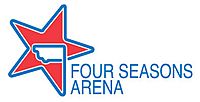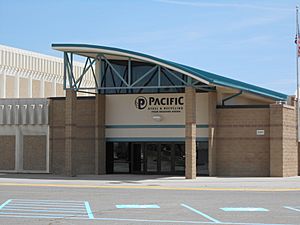Four Seasons Arena facts for kids
 |
|
| Location | 400 3rd Street NW, Great Falls, Montana, U.S. |
|---|---|
| Coordinates | 47°30′52″N 111°19′12″W / 47.51444°N 111.32000°W |
| Owner | Cascade County, Montana |
| Operator | Cascade County, Montana |
| Capacity | Basketball: 5,054 Concert: 5,870 Rodeo: 4,146 |
| Opened | 1979 |
| Tenants | |
| Great Falls Americans (WHL) (1979–1980) Montana Golden Nuggets (CBA) (1980–1983) Great Falls Americans (AFHL/AWHL) (1995–2003) Great Falls Explorers (CBA) (2006–2008) |
|
The Four Seasons Arena is a large indoor building in Great Falls, Montana, United States. It's used for many different things like sports, concerts, and shows. The arena was built in 1979. For a long time, it was mainly an ice rink.
However, problems with the ice rinks led to changes. By 2006, the main ice rink was closed. The building then became a space for other sports and events. In November 2018, leaders in Cascade County started planning to replace the arena. They proposed a new arena that would cost $86 million and seat 10,000 to 12,000 people. Voters decided on this plan in November 2019. The Four Seasons Arena was once the biggest event space in Great Falls.
Contents
Building the Arena
Before the Four Seasons Arena was built, Great Falls didn't have a big indoor sports center. High school gyms and other places were too small for large events. This made it hard for professional sports teams to grow in the city. It also meant Great Falls couldn't host big high school sports tournaments.
In 1977, a group called Leadership Great Falls suggested the city build a large indoor arena. A city leader, John St. Jermain, worked hard to make this happen. Voters first said no to using city money for it in 1977. But in 1978, St. Jermain helped get a federal grant to pay for most of the building costs.
The Four Seasons Arena was built in 1979 at the Montana State Fairgrounds. Because of how it was funded, the arena was smaller than first planned. It was mostly built as an ice rink and didn't even have air conditioning at first. The arena had two ice rinks: a main one and a smaller practice rink. The main rink could be changed from ice to a basketball court or rodeo arena in about four days. When it first opened, the main arena could seat 6,314 people.
In 1994, Great Falls voters approved money to improve the fairgrounds. This included renovating the Four Seasons Arena. A new Exhibition Hall was built in 1995. This hall could seat up to 1,500 people.
Arena History and Changes
The Four Seasons Arena was owned by Cascade County, Montana. Even though it wasn't designed for everything, it quickly became a multi-purpose venue. This heavy use caused the building to wear out fast. By 1987, the fairgrounds and arena were in debt.
The city of Great Falls took over managing the arena in 1988. But the building was already in poor condition. For example, a big roof leak in 1989 forced a high school basketball tournament to move. In 2001, the arena's heating and ventilation system was updated. A study also showed that the ice rinks needed $1.5 million in repairs.
Ice Rink Challenges
The city's management agreement ended in 2003. Cascade County decided to take over again. They hired a company called SMG World to manage the fairgrounds and arena. SMG found serious problems with both ice rinks. In 2003, the practice ice rink was leaking and uneven. Fixing it would cost a lot of money.
The cooling system for the practice ice failed in April 2003. Experts said repairs would cost $450,000, which the county didn't have. So, the practice ice rink closed for good. The Great Falls Americans junior hockey team moved away because of the limited ice time.
New Uses and Improvements
With less ice, the Four Seasons Arena looked for other events. It started hosting high school basketball tournaments. In December 2003, the old practice ice area was remodeled. This new space, called "Side 2," became a viewing area. It was used for watching live rodeo broadcasts and even had a mechanical bull.
In 2005, the arena offered ice only for a few months. Eventually, SMG decided to stop offering ice events in the main arena permanently. This allowed the arena to host more money-making events like basketball. In 2009, the Four Seasons Arena finally got air conditioning. The next year, money was loaned to replace and fix bleachers. The concessions area and "green room" were also improved.
Future Plans for the Arena
In 2010, a study looked at making big changes to the fairgrounds and Four Seasons Arena. It found problems like crumbling foundations and poor acoustics in the arena. The study suggested options like building a larger arena or converting the Four Seasons into an exhibition hall.
Around the same time, a private group announced plans for a new $40 million sports arena south of the city. This new facility would have indoor soccer fields, basketball courts, and a wrestling area. It would also include a larger multi-purpose arena for football and rodeos. Construction on the first part of this project was planned to start in the summer of 2011.
Events at Four Seasons
The Four Seasons Arena has hosted many exciting events over the years.
Professional Sports Teams
The arena was home to the Great Falls Americans professional hockey team in 1979. It also hosted the Montana Golden Nuggets basketball team from 1981 to 1983. Later, the Great Falls Explorers basketball team played there from 2006 to 2008.
Special Events and Famous Visitors
Many special events have taken place at the arena. In 1989, Great Falls boxer Todd Foster had his first professional fight there. Music legend Bob Dylan performed in 2005. The first MayFaire concert, featuring Trisha Yearwood, was held there in 2006. In 2011, the arena hosted the city's first mixed martial arts event.
Important leaders have also visited. President George W. Bush spoke there in 2005. Presidential candidate Barack Obama visited in 2008. President Donald Trump also spoke at the arena in 2018.
High School Basketball Tournaments
The Four Seasons Arena has been a popular spot for high school basketball. It has hosted the Montana Class AA boys' tournament several times. It also hosted the Class A boys' tournament in 2010. The arena has been the site for many Class B boys' tournaments over the years.
Class C basketball tournaments, which involve many schools across Montana, have also been held here. The arena hosted the Class C state boys' tournament in 1999. In 2005, it held the first-ever combined Northern Division Class C boys' tournament. It also hosted the Class C girls' state tournament in 2010.
Other Sports Events
Rodeo events are a big part of the arena's history. The Montana Pro Rodeo Finals have been held there every year since 1980. The arena also hosted the first World Professional Bull Riding Finals in 1999 and 2000.
The Terry Casey Memorial Cup, a national high school hockey tournament, was held at Four Seasons in 2000, 2006, and 2008. In 2006, the arena hosted the Northern Native American Classic, a basketball tournament for high schools with many Native American students. In 2008, a large cutting horse competition took place there.
Other Annual Events
Many other large events happen at Four Seasons Arena each year.
The Montana Agricultural Industrial Exhibit (MAGIE) is a big farm and ranch show. It brings people from many states and Canada. This show has been held at the arena almost every year since 2000. The arena also hosted the first joint meeting of the Montana Grain Growers Association and Montana Stockgrowers Association in 2000.
Since 1999, parts of Western Art Week have been held at the arena. The Great Falls Gun and Antique Show and the Electric City Kennel Club dog show also started holding their annual events there in 2002. In 2005, the popular What Women Want Expo moved to the Four Seasons because it needed a bigger space.
Arena Features
The Four Seasons Arena is built with concrete and steel. The inside walls are concrete with special sound-absorbing panels. The floor is polished concrete, and the ceiling shows exposed steel beams.
The main hall is a large rectangular space, about 141 by 222 feet. This gives it a total area of 33,000 square feet. The "Side 2" room is about 80 by 222 feet, with an area of 17,000 square feet. Both rooms have a ceiling clearance of 28 feet. The arena has nine dressing rooms, other service rooms, and an office. The Exhibition Hall is connected to the arena and is about 220 by 80 feet. The wall between the main room and Side 2 can be removed to create an even larger space.
The arena has permanent bleachers on the east, west, and north sides. More temporary bleachers and chairs can be added to increase seating for concerts or other events.
Supporting the Arena
The Four Seasons Sports Foundation is a private group that helps the arena. This foundation raises money to help pay for the costs of bringing sporting events to the Four Seasons Arena. The arena pays about half the cost, and the foundation pays the other half. In 2011, George Geise, a local sports writer, became chairman of a new committee for the foundation. His job was to work with local businesses and sports groups to make the arena more attractive for hosting events.



